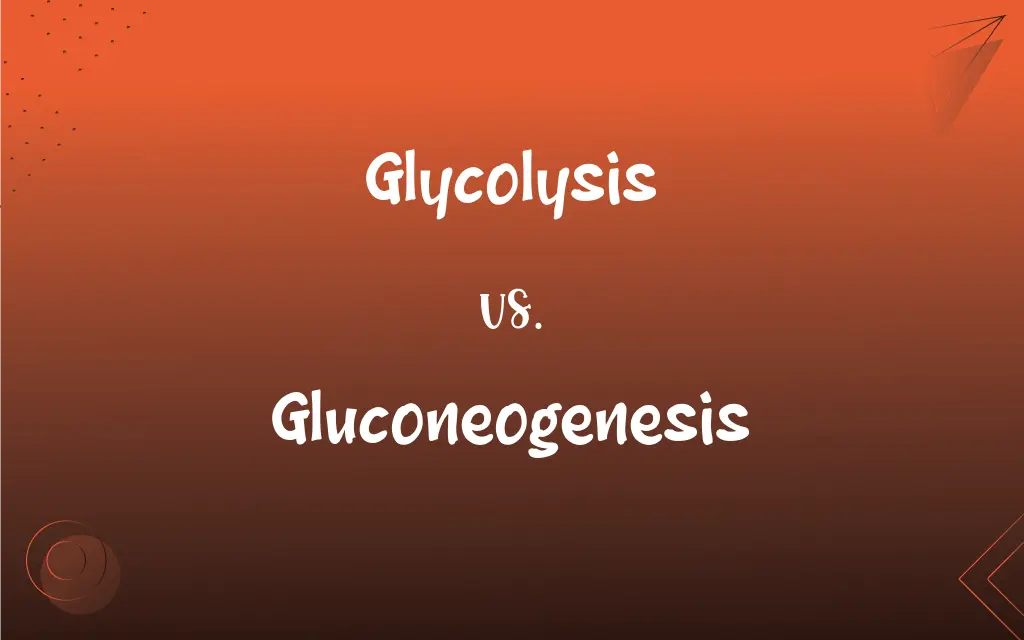Glycolysis vs. Gluconeogenesis: What's the Difference?
Edited by Aimie Carlson || By Harlon Moss || Published on November 14, 2023
Glycolysis is the metabolic process of breaking down glucose to produce energy, while gluconeogenesis is the synthesis of glucose from non-carbohydrate sources.

Key Differences
Glycolysis and gluconeogenesis are central metabolic pathways in the body. Glycolysis is a catabolic process, meaning it breaks down glucose molecules to generate energy in the form of adenosine triphosphate (ATP). This process involves multiple enzymatic reactions that convert glucose into pyruvate, releasing energy that's used by the body's cells.
Gluconeogenesis, in contrast, is an anabolic pathway, which means it constructs molecules. Specifically, it synthesizes glucose from non-carbohydrate precursors, such as lactate, amino acids, and glycerol. This pathway is especially crucial when the body's carbohydrate stores are low, ensuring a steady supply of glucose for cells, especially those in the brain.
While glycolysis predominantly occurs in the cytoplasm of cells, parts of gluconeogenesis take place in both the mitochondria and the cytoplasm. The balance between these pathways is crucial. Under conditions where energy is needed immediately, such as intense physical activity, glycolysis is favored. Conversely, during fasting or prolonged exercise, gluconeogenesis becomes more active.
Another crucial distinction is the regulation of these processes. They are not simply reverse processes of each other. Although some enzymes are shared between glycolysis and gluconeogenesis, each pathway has unique enzymes that regulate its direction and rate. This ensures that both pathways don't operate simultaneously in a given cell, avoiding a futile cycle.
Comparison Chart
Process Type
Catabolic
Anabolic
ADVERTISEMENT
Primary Function
Breakdown of glucose to produce energy
Synthesis of glucose from non-carbohydrate sources
Location
Cytoplasm
Both cytoplasm and mitochondria
Regulation
Regulated by enzymes specific to glycolysis
Has its own unique regulatory enzymes
Relationship with Energy
Releases energy in the form of ATP
Consumes energy to produce glucose
Glycolysis and Gluconeogenesis Definitions
Glycolysis
A series of reactions converting glucose to pyruvate.
Glycolysis results in the net production of 2 ATP molecules.
ADVERTISEMENT
Gluconeogenesis
An anabolic metabolic pathway.
Gluconeogenesis is vital for maintaining blood sugar levels.
Glycolysis
Central to cellular respiration.
Glycolysis is the first step in the breakdown of glucose in cells.
Gluconeogenesis
The synthesis of glucose from non-carbohydrate sources.
Gluconeogenesis ensures glucose supply during fasting.
Glycolysis
Produces energy for immediate cellular needs.
When oxygen is scarce, cells depend more on glycolysis.
Gluconeogenesis
Occurs in both the cytoplasm and mitochondria.
Certain steps of gluconeogenesis require mitochondrial enzymes.
Glycolysis
The metabolic process of breaking down glucose.
During exercise, muscles rely on glycolysis for energy.
Gluconeogenesis
Essential during prolonged energy demands.
During long periods of exercise, gluconeogenesis supports energy needs.
Glycolysis
A catabolic pathway in the cytoplasm.
Enzymes facilitate each step of glycolysis.
Gluconeogenesis
Opposite to glycolysis in function.
While glycolysis breaks down glucose, gluconeogenesis creates it.
Glycolysis
A metabolic process that occurs in nearly all living cells in which glucose is converted in a series of steps to pyruvic acid and during which energy is released in the form of ATP.
Gluconeogenesis
The formation of glucose, especially by the liver, from noncarbohydrate sources, such as amino acids and the glycerol portion of fats.
Glycolysis
(biochemistry) The cellular degradation of the simple sugar glucose to yield pyruvic acid, and ATP as an energy source
Gluconeogenesis
(biochemistry) The metabolic process in which glucose is formed, mostly in the liver, from non-carbohydrate precursors
Glycolysis
A metabolic process that breaks down carbohydrates and sugars through a series of reactions to either pyruvic acid or lactic acid and release energy for the body in the form of ATP
FAQs
What is the main function of gluconeogenesis?
The main function of gluconeogenesis is the synthesis of glucose from non-carbohydrate sources.
Where does glycolysis primarily occur?
Glycolysis primarily occurs in the cytoplasm of cells.
Is glycolysis the breakdown or synthesis of glucose?
Glycolysis is the breakdown of glucose.
Why is glycolysis crucial during anaerobic conditions?
In anaerobic conditions, cells rely on glycolysis for ATP production as the oxygen-dependent processes are limited.
What role do enzymes play in glycolysis?
Enzymes facilitate and regulate the individual reactions within the glycolysis pathway.
How is gluconeogenesis regulated?
Gluconeogenesis is regulated by specific enzymes and hormonal cues, ensuring it doesn't operate simultaneously with glycolysis.
Why is gluconeogenesis important during fasting?
Gluconeogenesis ensures a steady supply of glucose when dietary carbohydrates are unavailable.
Does glycolysis produce or consume energy?
Glycolysis produces energy in the form of ATP.
Is gluconeogenesis simply the reverse of glycolysis?
No, while they are related, they have distinct pathways and regulatory enzymes.
Can glycolysis and gluconeogenesis operate simultaneously?
No, to avoid a futile cycle, they are regulated to not operate simultaneously in the same cell.
Does gluconeogenesis only occur during fasting?
No, while it's more active during fasting, gluconeogenesis can occur whenever there's a need for glucose synthesis.
From what molecules can gluconeogenesis produce glucose?
Gluconeogenesis can produce glucose from lactate, amino acids, and glycerol.
In what cellular location does gluconeogenesis occur?
Gluconeogenesis occurs in both the cytoplasm and the mitochondria.
What determines the balance between glycolysis and gluconeogenesis?
Factors like energy needs, availability of substrates, and hormonal regulation determine the balance.
Which pathway is considered anabolic: glycolysis or gluconeogenesis?
Gluconeogenesis is an anabolic pathway.
What is the link between glycolysis and cellular respiration?
Glycolysis is the first step in cellular respiration, breaking down glucose for further energy-producing reactions.
Is glycolysis unique to humans?
No, glycolysis is a universal pathway present in nearly all living organisms.
Why is gluconeogenesis vital for the brain?
The brain primarily uses glucose for energy, and gluconeogenesis ensures glucose supply when dietary sources are scarce.
Can glycolysis operate in the absence of oxygen?
Yes, glycolysis can operate anaerobically, without the need for oxygen.
What are the end products of glycolysis?
The end products of glycolysis are pyruvate, ATP, and NADH.
About Author
Written by
Harlon MossHarlon is a seasoned quality moderator and accomplished content writer for Difference Wiki. An alumnus of the prestigious University of California, he earned his degree in Computer Science. Leveraging his academic background, Harlon brings a meticulous and informed perspective to his work, ensuring content accuracy and excellence.
Edited by
Aimie CarlsonAimie Carlson, holding a master's degree in English literature, is a fervent English language enthusiast. She lends her writing talents to Difference Wiki, a prominent website that specializes in comparisons, offering readers insightful analyses that both captivate and inform.






































































